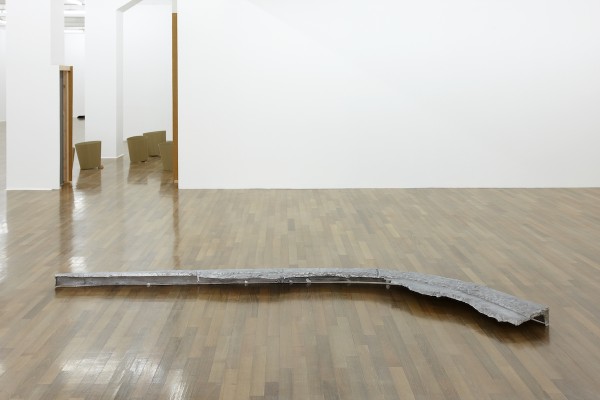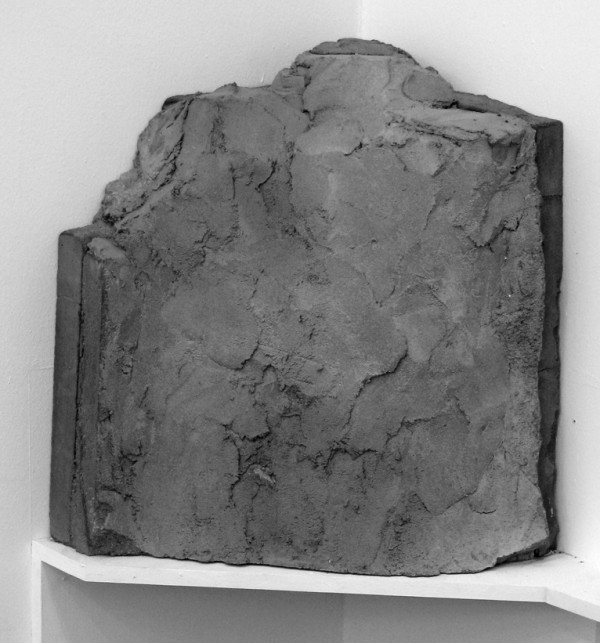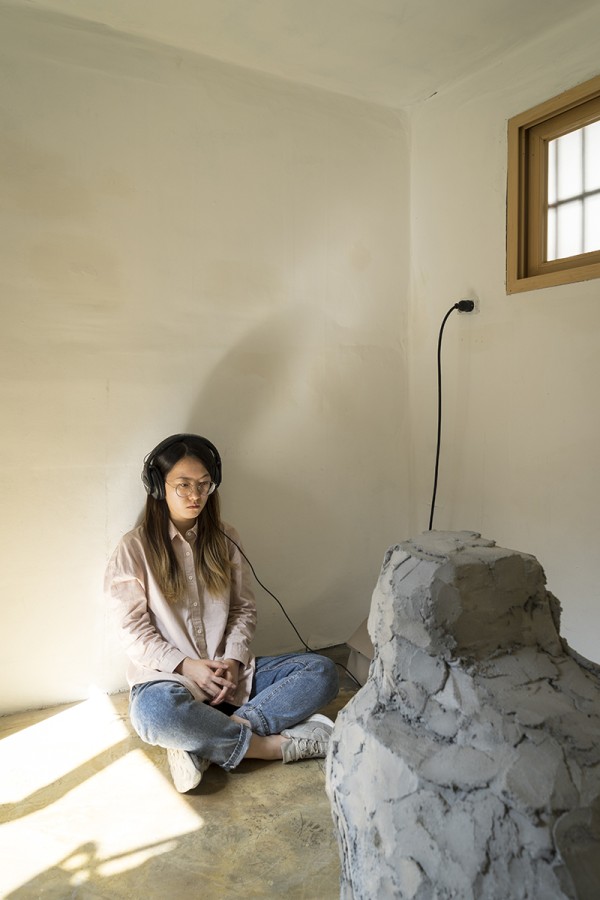Unexpected Moments of Sculpture
What to make of large scrap-like pieces of metal strategically placed on the floor? Or a tabletop with a chunk cut out of the corner? These questions come to mind as one searches for appropriate tools to assess Chung Seoyoung’s sculpture and multi-media work. Appropriately enough, such works emphasize the arbitrary and rootless nature of things. Chung also uses elements of the absurd to invest material objects with a sense of ambiguity.
Sculptures like Curb (2013) and Corner Stone (2011)—both featured in Ability vs. Invisibility, Chung’s first solo show in New York, at the Tina Kim Gallery—attempt to recalibrate our idea of aesthetics and of what sculpture can be. The cast aluminum Curb reproduces an ordinary slice of daily experience, singling out for attention a prosaic piece of functionality that would normally go unnoticed (except in moments of failure), while Corner Stone, a rough, shapeless blob of cement, playfully fills the gap left by right-angled, architectural order.
These deliberately humble anti-forms recast as art owe a considerable debt to Fluxus and its integration of life and art. During her years living in Germany, the Korean-born Chung has developed an acute conceptual edge, moving beyond cultural and other narratives to explore the nature of experience through the most minimal of means. One of the mot important artists in the post-Dansaekhwa generation, she continues to push traditional boundaries by disconcerting standardized thought processes and forcing us to consider new ideas in art and life.
Chung was born in the ’60s, when Dansaekhwa’s approach to Minimalism and monochromatic art was taking shape, inspired by nature and the properties of materials, particularly soft ones. By the ’90s, conceptual art began to overtake both formal abstraction and the Minjung style of social realism, which dominated South Korea in the ’80s. While Chung was studying sculpture, Yong-Ik Kim’s non-painterly rubber circles fixed to canvas set a deliberate provocation, deviating from formal norms and opening new avenues for challenging the status quo. Younger artists like Chung soon began to mount their own challenges and develop their own non-traditional methods.
For instance, her large-scale East West South North (2007) consists of two-foot-high metal fence segments configured to demarcate a rather large, but completely empty area. The title, which would seem to indicate a directional orientation for the four passage gates, has no correlation what soever to the placement of the somewhat uneven rectangular form. In other words, Chung’s arbitrary, even disorienting geographical pointers destabilize expectations of the guiding functionality of such signs. By confusing the viewers, East West South North, which Chung describes as “neither model nor actual architecture,” pushes us to experience what she calls “infinitely opened space,” in other words, space unrestricted by designations.
In Table (2007), Chung has performed a similar operation, neatly sawing off a portion of the tabletop and adjoining leg. The altered appearance is meant to redefine our idea of a table and its use. For Chung, titles are another type of work in themselves; she uses “language to shape the lineaments of a piece or gesture beyond [its] boundaries to where it might lead.” Sometimes language hints at what is not seen, as in East West South North and Table; other times, it serves as an eye-opening lens through which to view an object or situation, creating a space for imagination. In order to unsettle expectations and meanings, Chung constantly interrogates conventions of language and visual representation, forcing us to reconsider fixed notions of objectivity. In this way, she directs attention to non-visible notions of space with the intention of perpetuating a “sculptural approach.” The mismatched equation that titled her show—“Ability vs. Invisibility”—hints at how she conceives of these imaginary confrontational zones of strangeness, which cannot be understood as simple competitions or oppositions between two things. Instead, “the effect of such confrontation can be achieved only by discovering a new dimension within that confrontational composition. This is deeply related to my interest in objects as social evidence, and my effort to recognize the unexpected moment when a sculpture arises.”
This idea is elucidated in her installation Nobody Notices It (2012-16). Here, viewers are invited to sit on an antiquated-looking, “vaguely anthropomorphic” cement form, don headphones, and listen to “2005/1” a composition by the Swiss composer Manfred Werder that was recorded daily at 10 a.m. at the central train station in Zurich. Listening to this work about the world out-side of the work—which as Werder explains, tries to break the dyad between performer and listener—one begins to construct and re-create the invisible environment from the ambient sounds of human and mechanical movements, announcements, and conversations. For Chung, this reorientation also applies to vision: “It may be preposterous to gaze at the cement piece while listening to the sounds, or to experience sculpture in a state that is not formal/customary. Sculpture…indicates something physical and tangible. I go beyond this limitation…and think of both sounds and texts as immaterial or non-material sculpture. Thus the experience of listening, at least for me, can be described as a ‘sculptural experience,’ because the energy exerted in using our auditory senses to interpret the world around us creates some kind of intangible substance, which becomes the sculpture.”
This idea of reimagining form and space from sound and visual dislocation is paramount to Chung’s practice. Time and again, she gives ordinary, everyday life—be it the curbside or the railway station—central billing, using cheap, Korean-made construction materials to explore perceptions of time and space. As she explains, “Space and time are requisite conditions for comprehending the problems of reality, body, and objects more broadly. In other words, through the abstractness provided by space and time, the conditions for understanding the world can infinitely expand and be intensely challenged.” Following this approach, her work magnifies the effect of looking beyond thee physical and tangible aspects of sculpture to create a realm of “sculptural experience” that is both of and not of the surrounding world.





